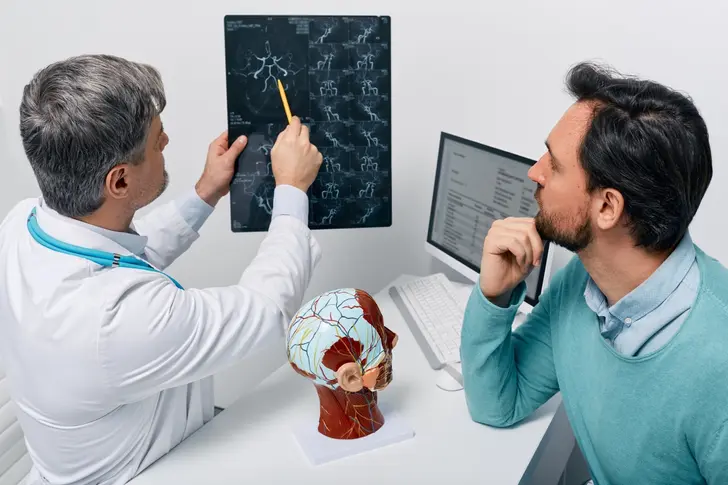- Headaches Overview
- Migraine
- Cluster & Tension Headaches
- Other Types of Headaches
- Appointment Prep
- View Full Guide
Understanding Rare Types of Migraine


Understanding Rare Types of Migraine
Most people know about regular migraines with head pain, but some rare types cause unusual symptoms. These uncommon migraines can be harder to recognize and diagnose because they don't match the symptoms most people associate with migraine.

Hemiplegic Migraine
This rare migraine causes temporary weakness on one side of your body, similar to a stroke. You might have trouble moving your arm or leg, experience slurred speech, or feel confused, along with the usual migraine symptoms.


Ocular Migraine
This type affects vision in just one eye, causing temporary blindness or seeing flashing lights. Unlike regular migraine auras that affect both eyes, retinal migraines impact only one eye and can be quite frightening. The light from electronic screens can be a trigger for these.

Basilar Migraine
Basilar migraines, also known as migraine with brainstem aura, affect the brainstem and cause symptoms like slurred speech, ringing in the ears, and severe dizziness. These symptoms happen before the headache starts and can be mistaken for other serious conditions.

Abdominal Migraine
Although anyone can get abdominal migraines, they mostly affect children ages 5-9. You usually feel the pain from these right behind the belly button. It might feel like mild soreness, or it could be severe. Along with abdominal pain, you typically feel nauseous and throw up.
PHOTO CREDITS:
Slide 1: Peakstock/Shutterstock
Slide 2: Prostock-studio/Shutterstock
Slide 3: BlurryMe/Shutterstock
Slide 4: PR Image Factory/Shutterstock
Slide 5: Kulkova Daria/Shutterstock
Slide 6: Arturs Budkevics/Shutterstock
SOURCES:
Shin Beh, MD, director, Vestibular Neurology and Neuro-Visual Disorders Clinic, University of Texas Southwestern Medical Center, Dallas.
American Hearing Research Foundation: “Meniere’s Disease,” “Migraine Associated Vertigo (MAV).”
American Migraine Foundation: “What to Know About Vestibular Migraine.”
Brain: “Vestibular migraine treatment: a comprehensive practical review.”
Cleveland Clinic: “Erenumab injection,” “Vestibular Disorders.”
FDA: “Breakthrough Devices Program,” “De Novo Classification Request for Cefaly Device,” “Emergency Use of gammaCore Sapphire CV During the COVID-19 Pandemic,” “GammaCore Sapphire CV,” “SpringTMS.”
Journal of Neurology: “Vestibular Migraine: The Most Frequent Entity of Episodic Vertigo.”
Johns Hopkins Medicine: “Vestibular Migraine.”
Mayo Clinic: “Galcanezumab-gnlm (subcutaneous route),” “Migraine,” “Ocular Migraine: When to Seek Help.”
Menieres: “Migraine-associated vertigo.”
Merriam-Webster Dictionary: “Vestibular.”
National Library of Medicine: “New Anti-CGRP Medications in the Treatment of Vestibular Migraine,” “Vestibular Migraine or Meniere’s Disease: A Diagnostic Dilemma.”
NeurologyLive: “Managing Vestibular Migraine: Optimizing Diagnosis and Treatment.”
NewPort-Mesa Audiology Balance & Ear Institute: “Addressing Dizziness and Balance Issues in Children.”
Cephalalgia.
UC Davis Health: Department of Otolaryngology: “Migraine Diet Table.”
U Health University of UTAH School of Medicine: “Vestibular (Dizzy) Migraine.”
Upstate University Hospital Comprehensive Stroke Center: “Brainstem Stroke.”
VEDA: “Natural Supplements for Vestibular Disorders.”
UpToDate: “Pathophysiology, clinical manifestations, and diagnosis of migraine in adults,” “Vestibular migraine.”
Vestibular Disorders Association: “Vestibular Migraine (a.k.a. Migraine Associated Vertigo or MAV).”
Association of Migraine Disorders: “Fifty Shades of Migraine: Vestibular, Hemiplegic & Migraine with Brainstem Aura.”